Today in our series on film star photographers, Aldo Graziati (1905-1953) or simply Aldo. The Italian is known as the cinematographer of some of the classic films by Luchino Visconti. But before that, Aldo worked in France as a still photographer and he made iconic studio portraits of the most beautiful stars of the French cinema.
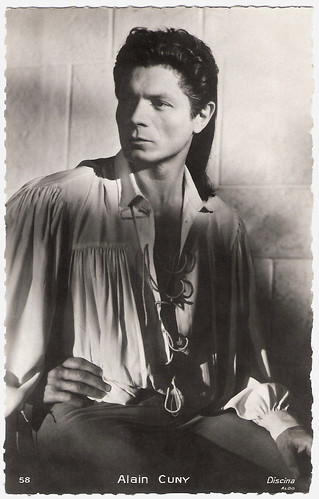
Alain Cuny. French postcard by E.C. Paris, no. 58. Photo: Aldò Graziati / Discina. Publicity still for Les visiteurs du soir (Marcel Carné, 1942).
During his career as an actor, photographer, cameras operator and cinematographer Aldo Rossano Graziati was credited as Aldo Rossano, Aldo, G. Aldo and G.R. Aldo.
In 1947, he shot his first film, the short French documentary Couleur de Venise/Colour of Venice (Jean Faurez, Jacques Mercanton, 1947).
A year later, he worked with Luchino Visconti on the neorealist classic La Terra Trema/The Earth Trembles (Luchino Visconti, 1948), loosely adapted from Giovanni Verga's novel I Malavoglia (The House by the Medlar Tree).
The picture, a docufiction about the exploitation of working-class fishermen on Sicily, features non-professional actors, including the brothers Antonio Arcidiacono and Giuseppe Arcidiacono.
Aldo's sensitivity to location in this drama of poor Sicilian fishermen produced never-to-be-forgotten images in black-and-white. The physical beauty of the sea scenes and the contrasting landscapes never obscured the neorealistic approach of its director. La Terra Trema/The Earth Trembles received a Golden Lion at the 9th Venice International Film Festival in 1948.
Aldo was also the cinematographer of the Italian historical drama Cielo sulla palude/Heaven over the Marshes (Augusto Genina, 1949) portraying the life of the saint Maria Goretti, and the drama Domani è troppo tardi/Tomorrow Is Too Late (Léonide Moguy, 1950) with Pier Angeli. The film was awarded Best Italian Film at the Venice Film Festival.
Aldo worked three times for director Vittorio De Sica as the cinematographer of Miracolo a Milano/Miracle in Milan (Vittorio de Sica, 1951), the neorealist classic Umberto D. (Vittorio de Sica, 1952), and Stazione Termini/Indiscretion of an American Wife (Vittorio de Sica, 1953), starring Jennifer Jones and Montgomery Clift.
He also worked as one of the cinematographers of Orson Welles' mythical Othello (1952). The film won the Best film award at the Cannes Film Festival in 1952.
Aldo's final film was the drama Senso (Luchino Visconti, 1954) with Alida Valli and Farley Granger. Senso was Visconti's and Aldo's first colour film and they obviously had put a lot of effort to it. Senso is visually gorgeous and meant an aesthetic revolution for Italian cinema.
During the production of the film, Aldo was killed in a car crash in Albara di Pianiga near Padua on 14 November 1953. British cinematographer Robert Krasker completed the film.
Aldo's cinematography for the film later received the Italian National Syndicate of Film Journalists' award. Visconti was nominated for the Golden Lion award at the 15th Venice International Film Festival.
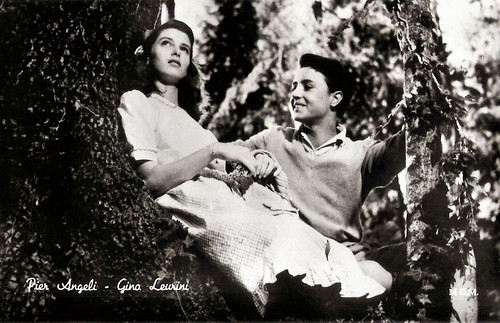
Pier Angeli and Gino Leurini in Domani è troppo tardi/Tomorrow Is Too Late (Léonide Moguy, 1950). Italian postcard. Photo: M.G.M.
Aldo Rossano Graziati was born in Scorzè, Italy in 1905. As a boy, he already loved to travel and in 1923 he moved to France to become an actor.
Aldo worked on stage and began his film career as a supporting actor in the French silent film L'ile d'amour/The Island of Love (Berthe Dagmar, Jean Durand, 1929), credited as Aldo Rossano. But soon he gave up this profession.
He kept his hand in the film business, and became a still photographer. He kept this position for nearly 20 years. He made the stills for such classics of the French cinema as L'éternel retour (Jean Delannoy, 1943) with Madeleine Sologne and Jean Marais, La vie de bohème (Marcel L'Herbier, 1945) starring Maria Denis and Louis Jourdan, and the romantic fantasy La belle et la bête (Jean Cocteau, 1946) with Jean Marais and Josette Day.
His eye was always on becoming a cinematographer and he worked his way up to assistant cameraman. Then the slow starter became the camera operator for such French films as L'empreinte du Dieu/Two Women (Léonide Moguy, 1940) with Pierre Blanchar, and La symphonie fantastique/The Fantastic Symphony (Christian-Jacque, 1942) with Renée Saint-Cyr.
In the early 1940s, Aldo alternated the work of camera operator (often with Roger Hubert) to work as a portrait photographer for the well-known Studio Harcourt in Paris, for which Cecil Beaton and Paul Ronald also worked. He also worked for Discina. His stills and portraits show a flair for aesthetic shots and his admiration for Caravaggio. In his later camera work for La Terra Trema (1948) this influence is also recognizable.
Finally he secured the position of full-fledged cinematographer. According to Wikipedia, his first feature as a cinematographer was La Chartreuse de Parme/The Charterhouse of Parma (Christian-Jaque, 1948), starring Gérard Philipe and Maria Casares. However, IMDb credits him as the still photographer at that film.
When the Nazis occupied France, he fled to Nice. There he met Michelangelo Antonioni, who brought him back to Italy. Antonio introduced him to his friend Luchino Visconti, who asked him to undertake the photography for La Terra Trema (1948). Thus Aldo became a key figure in the neorealist cinema.
According to Albert Steeman at the Internet Encyclopedia of Cinematographers, Aldo "created some of the most influential black-and-white films of his time. He is, in many opinions, the greatest among the neorealist cinematographers, and his most miraculous achievement was to respect and portray the reality of life by maximizing the potential of the camera and lights."
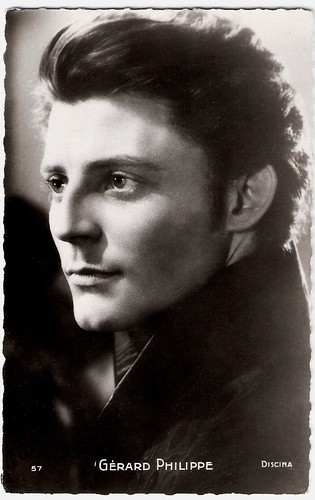
Gérard Philipe. French postcard by Editions P.I., Paris, no. 57. Photo: Discina.
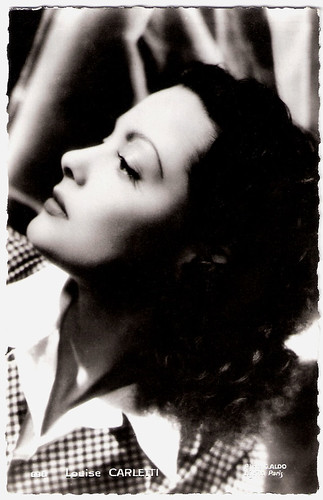
Louise Carletti. French postcard by Collection Chantal, no. 838. Photo: G. Aldo / Discina, Paris.
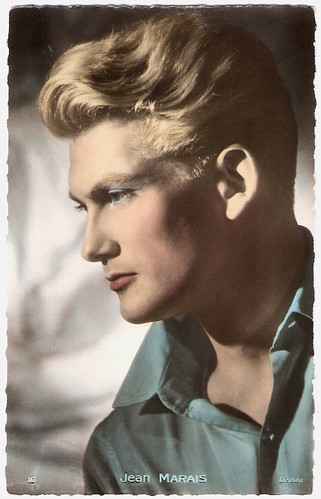
Jean Marais. French postcard by Editions E.C., Paris, no. 10. Photo: Discina.

Michèle Morgan. French postcard by Edit. Chantal, Rueil, no. 571. Photo: Discina, Paris.
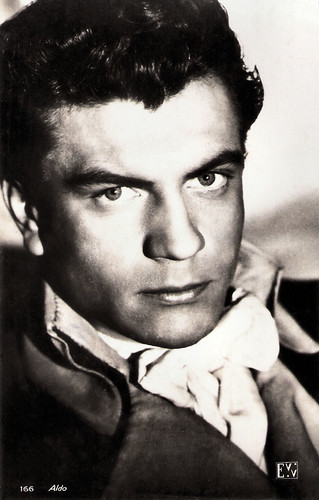
Henri Vidal. French postcard by Editions Votre Vedette (EVV), no. 166. Photo: Aldo Graziati.
Check out our other posts on film star photographers. See the links at right under the caption 'The Photographers'.
Sources: Albert Steeman (Internet Encyclopedia of Cinematographers), Wikipedia (English and German) and IMDb.

Alain Cuny. French postcard by E.C. Paris, no. 58. Photo: Aldò Graziati / Discina. Publicity still for Les visiteurs du soir (Marcel Carné, 1942).
Visconti
During his career as an actor, photographer, cameras operator and cinematographer Aldo Rossano Graziati was credited as Aldo Rossano, Aldo, G. Aldo and G.R. Aldo.
In 1947, he shot his first film, the short French documentary Couleur de Venise/Colour of Venice (Jean Faurez, Jacques Mercanton, 1947).
A year later, he worked with Luchino Visconti on the neorealist classic La Terra Trema/The Earth Trembles (Luchino Visconti, 1948), loosely adapted from Giovanni Verga's novel I Malavoglia (The House by the Medlar Tree).
The picture, a docufiction about the exploitation of working-class fishermen on Sicily, features non-professional actors, including the brothers Antonio Arcidiacono and Giuseppe Arcidiacono.
Aldo's sensitivity to location in this drama of poor Sicilian fishermen produced never-to-be-forgotten images in black-and-white. The physical beauty of the sea scenes and the contrasting landscapes never obscured the neorealistic approach of its director. La Terra Trema/The Earth Trembles received a Golden Lion at the 9th Venice International Film Festival in 1948.
Aldo was also the cinematographer of the Italian historical drama Cielo sulla palude/Heaven over the Marshes (Augusto Genina, 1949) portraying the life of the saint Maria Goretti, and the drama Domani è troppo tardi/Tomorrow Is Too Late (Léonide Moguy, 1950) with Pier Angeli. The film was awarded Best Italian Film at the Venice Film Festival.
Aldo worked three times for director Vittorio De Sica as the cinematographer of Miracolo a Milano/Miracle in Milan (Vittorio de Sica, 1951), the neorealist classic Umberto D. (Vittorio de Sica, 1952), and Stazione Termini/Indiscretion of an American Wife (Vittorio de Sica, 1953), starring Jennifer Jones and Montgomery Clift.
He also worked as one of the cinematographers of Orson Welles' mythical Othello (1952). The film won the Best film award at the Cannes Film Festival in 1952.
Aldo's final film was the drama Senso (Luchino Visconti, 1954) with Alida Valli and Farley Granger. Senso was Visconti's and Aldo's first colour film and they obviously had put a lot of effort to it. Senso is visually gorgeous and meant an aesthetic revolution for Italian cinema.
During the production of the film, Aldo was killed in a car crash in Albara di Pianiga near Padua on 14 November 1953. British cinematographer Robert Krasker completed the film.
Aldo's cinematography for the film later received the Italian National Syndicate of Film Journalists' award. Visconti was nominated for the Golden Lion award at the 15th Venice International Film Festival.

Pier Angeli and Gino Leurini in Domani è troppo tardi/Tomorrow Is Too Late (Léonide Moguy, 1950). Italian postcard. Photo: M.G.M.
Slow starter
Aldo Rossano Graziati was born in Scorzè, Italy in 1905. As a boy, he already loved to travel and in 1923 he moved to France to become an actor.
Aldo worked on stage and began his film career as a supporting actor in the French silent film L'ile d'amour/The Island of Love (Berthe Dagmar, Jean Durand, 1929), credited as Aldo Rossano. But soon he gave up this profession.
He kept his hand in the film business, and became a still photographer. He kept this position for nearly 20 years. He made the stills for such classics of the French cinema as L'éternel retour (Jean Delannoy, 1943) with Madeleine Sologne and Jean Marais, La vie de bohème (Marcel L'Herbier, 1945) starring Maria Denis and Louis Jourdan, and the romantic fantasy La belle et la bête (Jean Cocteau, 1946) with Jean Marais and Josette Day.
His eye was always on becoming a cinematographer and he worked his way up to assistant cameraman. Then the slow starter became the camera operator for such French films as L'empreinte du Dieu/Two Women (Léonide Moguy, 1940) with Pierre Blanchar, and La symphonie fantastique/The Fantastic Symphony (Christian-Jacque, 1942) with Renée Saint-Cyr.
In the early 1940s, Aldo alternated the work of camera operator (often with Roger Hubert) to work as a portrait photographer for the well-known Studio Harcourt in Paris, for which Cecil Beaton and Paul Ronald also worked. He also worked for Discina. His stills and portraits show a flair for aesthetic shots and his admiration for Caravaggio. In his later camera work for La Terra Trema (1948) this influence is also recognizable.
Finally he secured the position of full-fledged cinematographer. According to Wikipedia, his first feature as a cinematographer was La Chartreuse de Parme/The Charterhouse of Parma (Christian-Jaque, 1948), starring Gérard Philipe and Maria Casares. However, IMDb credits him as the still photographer at that film.
When the Nazis occupied France, he fled to Nice. There he met Michelangelo Antonioni, who brought him back to Italy. Antonio introduced him to his friend Luchino Visconti, who asked him to undertake the photography for La Terra Trema (1948). Thus Aldo became a key figure in the neorealist cinema.
According to Albert Steeman at the Internet Encyclopedia of Cinematographers, Aldo "created some of the most influential black-and-white films of his time. He is, in many opinions, the greatest among the neorealist cinematographers, and his most miraculous achievement was to respect and portray the reality of life by maximizing the potential of the camera and lights."

Gérard Philipe. French postcard by Editions P.I., Paris, no. 57. Photo: Discina.

Louise Carletti. French postcard by Collection Chantal, no. 838. Photo: G. Aldo / Discina, Paris.

Jean Marais. French postcard by Editions E.C., Paris, no. 10. Photo: Discina.

Michèle Morgan. French postcard by Edit. Chantal, Rueil, no. 571. Photo: Discina, Paris.

Henri Vidal. French postcard by Editions Votre Vedette (EVV), no. 166. Photo: Aldo Graziati.
Check out our other posts on film star photographers. See the links at right under the caption 'The Photographers'.
Sources: Albert Steeman (Internet Encyclopedia of Cinematographers), Wikipedia (English and German) and IMDb.
2 comments:
His portraits are wonderful.
Yes. It's a pity many of the photographers of French studios like Studio Harcourt and Discina are not identified on the postcards. I wonder if Aldo also made the other Discina portraits in this post, which don't contain his name.
Post a Comment